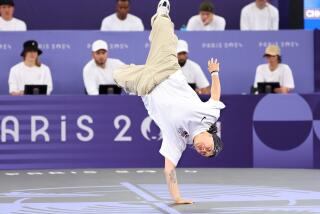âSo You Can Think You Can Danceâ: Nigel Lythgoe on showâs 10 seasons
Foxâs âSo You Think You Can Danceâ has ridden the wave of dance show popularity and will complete its 10th season with Tuesday nightâs finale.
Along with creating successful dancers and choreographers, the show (also known as âSYTYCDâ) can lay claim to introducing some big musical artists. Both Lady Gaga and Katy Perry had their first breakout national performances on the show.
Other artists whoâve been on the show early in their careers include Adele, OneRepublic and Goldfrapp. The show is also receiving more recognition this year with seven Emmy nominations, including one for host Cat Deeley, and a 42-city tour kicking off Oct. 1.
Executive producer Nigel Lythgoe, who along with Simon Fuller created âSYTYCD,â is also one of the judges. We caught up with him to talk about whatâs changed in the showâs first 10 seasons and where the dance world is now.
INTERACTIVE: Fall 2013 TV preview
ST: When you began the show, how did you think it would go?
NL: I will say that I wasnât anticipating that the show would be successful. Simon Fuller suggested that we do a show similar to his âAmerican Idolâ show. With my background as a dancer, we should look into doing it for dancing, and I didnât think it would work. Pure and simple because I didnât think the public wanted anything to do with dancing. âDancing With the Starsâ wasnât on the air yet and there was nothing in America, or anywhere else for that matter, that led me to believe that it would be successful. However, we tried âSo You Think You Can Danceâ as a pilot, and it was horrible. It just didnât work at all. We changed it around, and after that first series I thought we were getting on the right track. There were some really good dancers that came out of it. And the eventual winner, Nick Lazzarini, was fantastic. There was certainly talent here ripe to be picked. But the big thing to me was something that weâd never really taken into account. The choreographers, and how their stories turned out and how weâve watched them be creative and paint pictures for themselves. That, for me, was the thing that I was really most interested in at the end of the first season.
ST: âSYTYCDâ has had great staying power with itâs âdance and be judgedâ format. Is it the judges, the dancers, the story lines or a combination that is the secret to its success?
NL: The showâs secret to success is the American dream -- thatâs no secret. That is, the realization that you can shine and that there is an opportunity to shine, and this gives hope to these kids that may have come from nothing, may have not even have had the opportunity in the socio-demographic areas that they were in to get out of it. Dance has given them the opportunity, and âSo You Think You Can Danceâ has given them the platform. So, itâs a lot deeper than âdance and be judged.â A lot deeper. Like an onion. there are many layers, one that weâve touched on with the choreographers. Look at how theyâve developed. This country now knows choreographersâ names. Mia Michaels. Wade Robson. Travis Wall. And weâve reinvested in them. Travis was a contestant, and has come back. The genuine stories behind them. Mia Michaelsâ park bench routine and its impact on the Emmys.
I donât necessarily think the judges play anywhere near the part that they do on âAmerican Idol.â Weâre not really celebrities in that sense. Weâre just trying to be good, honest people. We donât want to cut anybodyâs legs off without rebuilding them with pointed toes. We want to be constructive with our comments and be helpful, while at the same time try not to pat them on the head and give them a lump of sugar.
PHOTOS: Cable versus broadcast ratings
ST: In the 10 seasons that âSYTYCDâ has been on, have you seen major changes in the dance world?
NL: What I would say is that dance has become far more acceptable in this country. Iâm seeing huge changes of elitism disappearing, and the ballet world is realizing that there is another world of dance out there that it may have been ignoring. I think that thereâs a lot of development and movement in that elite world, which is really good to see. I now see street kids that have had no formal training inspiring kids who have had formal training. The street kids also now know that thereâs an awful lot of hard work that they have to do, that they have to train their bodies and their minds when using classical forms as a technique and they can do even more with their own styles. I watched a kid this year, Fik Shun, get better and better at his own style because he began strengthening up in other areas. This realization has been occurring over the past six or seven years, and Iâm also watching families accept their children as dancers. They realize that theyâre not just dancers, they are athletes.
I think thereâs a lot more happening with inner-city kids too. Communities are using dance as we lose money from the arts for our schools and everything. Communities are getting together and realizing that we can put all of this information in a kidâs head, but if the kid isnât creative, theyâre not going to disseminate it very well. You need to be creative in this world, not just intelligent, and creativity and intelligence donât always go hand in hand, as far as I can see. Dance is such a great form to be creative and be good for your health that I think people are looking on dance in a totally different way. When I first started âSo You Think You Can Dance,â a black girl came up to me and said, âYou know, only white people will ever win this competition,â which knocked me back. I said âWell, why do you say that?â And she said, âBecause theyâre the only ones who can afford proper training.â Thank goodness she was wrong. It was something that needed to be addressed, and certainly it has been, and I think âSo You Think You Can Danceâ has made an impact in that area and shown the great beauty of the diversity of dance, and hopefully tried to give it the respect it deserves.
ST: In this 10th season, what has happened that surprised or affected you?
NL: I think the stand out surprise was that one of my favorites got cut early on. Iâll name names ... Aaron was not in our top 20, and made it to the four finalists, and Jasmine crept in. When we were discussing it, she wasnât in our top 10, and Cat Deeley really fought for her. Our minds were easily changed at that stage. It just shows the strength of everybody, and I think itâs the first time in the finals where I thought, âWow, I wish we could split the prize money four ways.â I donât think our two boys are exceptionally talented in technique, aside from Aaron with his tap and Fik Shun with his creativity, but they both bring something unique in terms of personality. Both our girls are fabulous in both technique and performance. America has a really tough job on their hands this week.
ST: What are a few of your favorite routines from over the years?
NL: I think Mia Michaelâs bench routine was certainly one of the first that made people think, âOh wow! This is about a serious subject here.â A sort of unrequited love that Mia Michaels had for a gay man that loved her, but couldnât love her in a physical way.
Wade Robsonâs Ramalama. Tyce Diorioâs breast cancer routine. Mia Michaelsâ addiction piece. Itâs perfect when the music is right, when the dancing is right, and when the dancers really understand what theyâre doing.
-- Jevon Phillips
ALSO:
Emmys 2013: Cat Deeley on âSo You Think You Can Danceâ
Paula Abdul to guest judge on âSo You Think You Can Danceâ
VIDEO: âSo You Think You Can Danceâ judges talk 9th season
More to Read
The complete guide to home viewing
Get Screen Gab for everything about the TV shows and streaming movies everyoneâs talking about.
You may occasionally receive promotional content from the Los Angeles Times.







